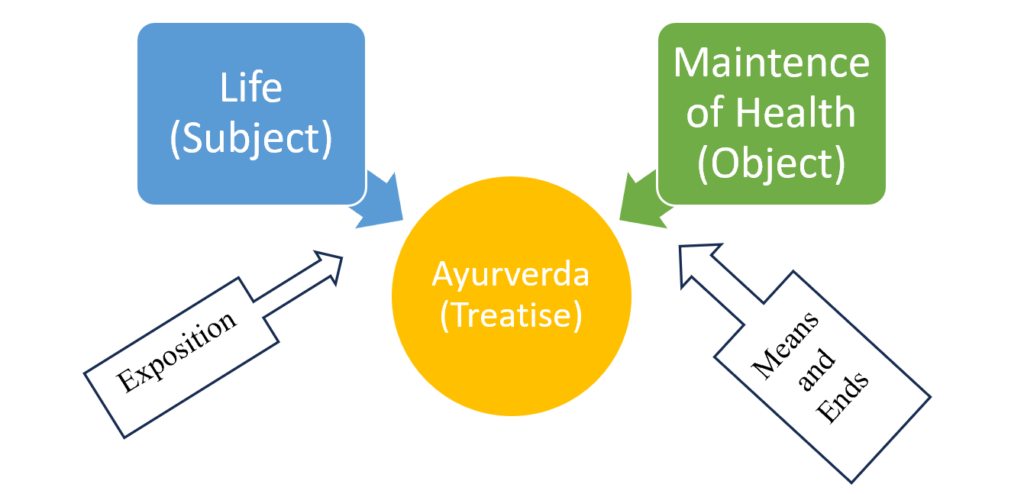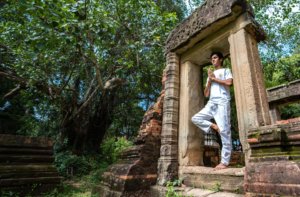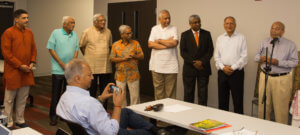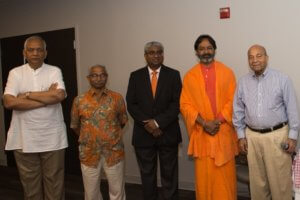Published by Arun Narayanan on Dec 4, 2023 1:10:31 AM
It is essential for a formal written or verbal work to state the topic and purpose clearly at the very beginning of the work. This creates an interest in the audience, and introduces rigor in the author’s method.

Crow’s Teeth
Now that you are reading, I assume the title ‘Crow’s Teeth’ piqued your interest. Birds do not have teeth, at least the modern ones, and crows, for sure, do not have them. So, what is the phrase doing as a title in a HUA blog? The term is referenced in two texts – Nyāya Mañjarī and Āyurveda Dīpikā. There is not much to this amusing term other than that these texts say investigating crow’s teeth is a superficial and uninteresting endeavor. These texts emphasize the importance of communicating the utility of the subject of a discourse lucidly. By discourse I mean written work like treatises and verbal work like expositions.
Nyāya Mañjarī is viewed as an independent work on Nyāya philosophy written in the 10th century (CE). Jayanta Bhaṭṭa, the author, was a poet, logician, scholar, and adviser to Kashmiri King Śaṅkara Varman of the Utpala dynasty. Though the work is independent, Jayanta based it on Nyāya Sūtra of ṛṣi Akṣapāda by selecting important topics and defending the essential features of the philosophy. Jayanta’s other prominent contribution to the world of Indian Knowledge Systems is his commentary on ṛṣi Pāṇini’s Ashtādhyāyī – a treatise on Sanskṛt grammar. While defending ṛṣi Akṣapāda, Jayanta uses the phrase crow’s teeth. J.V. Bhattacharya, in his translation (see references below) translates the words of Jayanta as follows (page 10):
Even a sentence which conveys sense, having its constituent words mutually connected, should be rejected as worthless if it answers no purpose like the following interrogatory one: “Are the teeth of crow good or bad?”
Āyurveda Dīpikā is an authoritative commentary on Caraka Saṁhitā written in the 11th century. Cakrpāṇi Datta, who authored the text, was an Āyurvedic practitioner and scholar from the Bengal region of India. Caraka Saṁhitā by Agniveśa, Suśruta Saṁhitā by Suśruta, and Aṣṭāṅga Hṛdaya of Vāgbhaṭa are recognized as Bṛhat-Trayi – the “Great Trio” of Āyurvedic texts. Cakrpāṇi, in his commentary, supplied grammatical, philosophical, and syntactic interpretations of complicated and technical terms (Sharma, R.K. and Dash, Bhagwan, page xl). In addition, Cakrpāṇi justified the arrangement of sections, chapters, and even statements in the chapters. The phrase Crow’s Teeth becomes relevant in this context. Sharma and Bhagwan, in their translations (see references below) translate Cakrpāṇi’s words as:
Intelligent people are not motivated towards (the study of) something indistinct like “ka,” ca,” “ta,” “pa,” etc., nor even towards something distinct but useless examination of the teeth of a crow.” (page 4)
As I pointed out earlier, the phrase “Crow’s Teeth” itself is unimportant. The point driven by both Cakrpāṇi and Jayanta – subject, object, and treatise relationship and that is the significant idea of this blog. Vedantasāra, another text succinctly captures this relationship as anubandha catuṣṭaya.
Jayanta’s point
Jayanta delivers a stunning technical explanation of Akṣapāda’s first Nyāya Sūtra. The sutra goes as:
pramāṇa-prameya- saṅśaya -prayojana-dṛṣṭānta-siddhāntāvayava-
tarka-nirṇaya-vāda-jalpa-vitaṇḍā-hetvābhāsa-cchalajāti-
nigrahasthānānāṃ tattvajñānān niḥśreyasādhigamaḥ. [1.1.1]
It is the knowledge of the real essence (or true character) of the following sixteen categories that leads to the attainment of the Highest Good – 1) The means of Right Cognition, 2) The objects of the Right Cognition, 3) Doubt, 4) Motive, 5) Example, 6) Theory, 7) Factors of Inference, 8) Cognition, 9) Demonstrated Truth, 10), Discussion, 11) Disputation, 12) Wrangling, 13) Fallacious Reason, 14) Casuistry 15) Futile Rejoinder and 16) Clinchers [Mahāmahopādhyāya Gaṅganatha Jhā translation]
He raises questions for potential objectors and answers them with a flourish. He devotes time to the purpose and effectiveness of the first sentence and general openings of a treatise.
He drives the point that to encourage the listeners of a treatise, it is essential to lay out the subject, broad divisions of the content, and the end goals at the beginning of any written work. He sees that scholars would not consent to hearing something if they were not informed of the broad outline of the subject, as the utility of hearing the treatise remains unknown.
Having introduced that the utility of a treatise is an important motivator for the listeners, Jayanta tries to answer how to prove that utility at the beginning. Jayanta questions the notion whether a mere statement of the utility of a treatise is a good enough motivator. He points out the problem that to know the utility of a discourse, we need to listen to it but to read the treatise, we should first understand its utility. He concludes that the first sentence of a treatise informs the listener about its utility, motivating him to listen to the whole treatise. Jayanta dives into the psychological condition of the listener or reader, who only partially accepts the utility, by saying that there might be doubt of the validity of the proposed utility. However, their mind is convinced to study the treatise to confirm the author’s exposition. He further sees that humans tend to pursue an activity destined to yield positive outcomes that are easy to perform. If the positive result is achievable, intelligent humans will figure it out within a few days.
Jayanta cautions us on the futility of scrutinizing the results before the action has been performed as such a preemptive tendency impedes progress to understanding. This might sound familiar with modern phrase analysis paralysis. He adds an analogy of how a sick person should not doubt the prescriptions given by a physician and the harm of following instructions. He concludes that the learner, having read the utility, should devote his best attention and sincerity to studying the explained subject before deciding on its usefulness.
Jayanta highlights the importance of the first sentence of a treatise saying the purpose or usefulness in a meaningful way. In this context, he brings up the useless characteristic of the question, “Are the teeth of a crow good or bad?” Jayanta believes the first sentence should attract listeners or readers and silence hostile critics. His conviction is that the first sentence can create the necessary doubt in the mind of the listeners or readers to explore the topic and find for themselves if the author was correct.
He summarizes that it is essential to tell the relationship between the treatise and its content, between the content and the results.
Cakrpāṇi’s point
Cakrpāṇi is commenting on the first verse of the first chapter, Dīrgha Jīvatīyam – (Quest for Longevity) of Caraka Saṁhitā. He explains that Caraka, to make it easy for the readers, brought in the subject, object, and relationship as stimuli for the readers. He adds that intelligent people are unmotivated to study something like the Sanskṛt alphabet. Sanskṛt consonants are arranged in rows called Varga, and each row is affixed a label based on the starting alphabet in that row. Next, he points out that intelligent people are not interested in a useless examination of a crow’s teeth.
Cakrpāṇi deems it necessary to specify the subject and object of a treatise at the beginning because if the relationship were not stated, it does not stimulate a learner. Cakrpāṇi contends that the above relationship is conveyed by the phrase “Dīrgha Jīvatīyam” and that Caraka elaborates on it later in the text. He considers the motivator “usefulness” for the treatise as motivating for its learners to study. He contends that mere enumeration of the object does not yield the treatise learner to learn its usefulness. He chastises some works where the author lists the objects but does not deliver on the promise. The author’s credibility alone does not suffice because the learner might be unable to discern the credibility. This leads to a circular problem similar to how Jayanta had described the issue – that a learner will not be attracted to a treatise without knowing its usefulness, and the effectiveness of the treatise cannot be decided unless the learner is drawn to the treatise and studies it.

Cakrpāṇi, so then, arrives at the next motivator, “doubt,” that could attract the learner to the treatise. There are two types of doubts, he goes on to say – a general doubt on the effectiveness of the treatise and another about the specific object of study. He drops the former type of doubt as less motivating than the latter and he does not provide supporting reasons for that perspective. Nevertheless, one can reasonably assume it is because the human mind is better able to understand specific and concrete objects and relationships than general ones.
Cakrpāṇi concludes that telling the utility of the treatise via its relationships is more accessible for its learners to understand and start studying it.
Vedantasāra
I have not encountered the phrase “crow’s teeth” in my other reading. However, the concept of saying the subject, connection of the topic to the treatise, and utility or necessity appears in other works and we can examine this concept in Vedantasāra.
Vedantasāra is a well-known Prakaraṇa Grantha on Advaita philosophy from the 15th century. It was composed by Sadānanda Yogīndra Sarasvatī and it is a revered text that follows traditional pedagogical methods.
Right at the beginning of the work, in verse five, Sadānanda introduces the concept of Anubandha. The verse is:
tatra anubandho nāma adhikāri viṣya saṁbandaprayojanāni [verse 5]
The preliminary questions of Vedanta are the determination of the competency of the student, the subject matter, its connection with the book and the necessity for its study [Swāmī Nikhilānanda translation].
Anubandha has four components: the qualification of a student, subject matter, connection of the subject with the treatise, and the necessity of the treatise. This is popularly known as anubandha catuṣṭaya and can be depicted as below.

Conclusion
We can apply these concepts to any formal discourse or writing. It is essential to clearly state the subject and end results to create an interest in the reader. Apart from increasing this curiosity, this framework which was analyzed and developed by our ancestors, encourages the author to be reflective and use rigor. In an information dissemination format such as this blog, a seemingly irrelevant phrase hook “crow’s teeth” would suffice for the readers to begin reading
References
English translations of all the texts were consulted for this writing and where it was critical, the original Sanskṛt texts were also studied to ensure correctness in meaning and interpretation.
- Caraka Saṁhitā by Agnivesa (redacted by Carka and Dṛḍhabala)
- Nyāya Mañjarī by Jayanta Bhaṭṭa
- Vedantasāra by Sadānanda Yogīndra
Translations
- Sharma, R.K and Dash, Bhagwan, Caraka Saṁhitā [Text with English translation & critical exposition based on Cakrpāṇi Datta’s Āyurveda Dīpikā ], Vol I, Chowkhamba Sanskrit Series Office, Varanasi, 2023
- Bhattacharya, Janaki Vallabha, Jayanta Bhaṭṭa’s Nyāya Mañjarī [The Compendium of Indian Speculative Logic], Motilal Banarsi Dass, New Delhi, 1978
- Swāmī Nikhilānanda, Vedantasāra (The Essence of Vedanta) of Sadānanda Yogīndra, Advaita Ashrama, Kolkata, 2021
- Jha, Mahāmahopādhyāya Gaṅgānātha, Gautama’s Nyāya Sūtras [with Vātsyāyana Bhāṣya], Oriental Book Agency (Poona, 1939)










